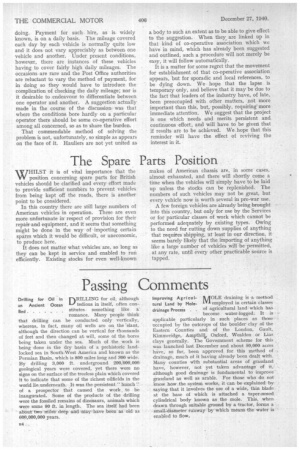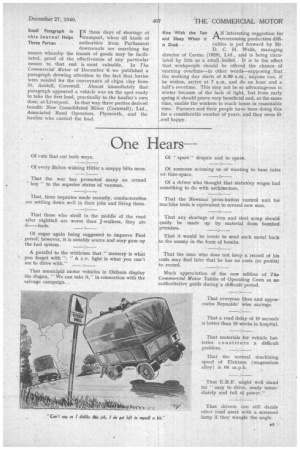Passing Comments
Page 12

Page 13

If you've noticed an error in this article please click here to report it so we can fix it.
nRILLING for oil, although tedious in itself, often constitutes something like a romance. Many people think that drilling can be conducted only vertically, whereas, in fact, many oil wells are on, the 'slant, although the direction can be vertical for thousands of feet and then changed at will, some of the bores being taken under the sea. Much of the work is being done in the dry basin of a prehistoric landlocked sea in South-West America and known as the Permian Basin, which is 800 miles long and 300 wide. By drilling 3,000 ft. underground 200,-000,000 geological years were covered, yet there were no signs on the surface of the treeless plain which covered it to indicate that some of the richest oilfields in the world lie underneath. It was the persistent "hunch " of a prospector that caused the work, to be inaugurated. Some of the products of the drilling were the fossiled remains of dinosaurs, animals which were seine 90 ft. in length. The sea itself had been about-two Miles deep and -may'have been as old as 600,000,000 years.
Drilling for Oil In an Ancient Ocean Bed..... . .
UOLE draining is a method L v' employed in certain classes of agricultural land which has become water-logged. It is applicable particularly in such places as those occupied by the outcrops of the boulder clay of the Eastern Counties and of the London, Gault, Kimmeridge, Ampthilif Oxford, Wealden or Lias clays generally. The Government scheme for this was launched last December and about 50,000 acres have, so far, been approved for this method of drainage, much of it having already been dealt with. Many counties With substantial areas of grassland have, however, not yet taken advantage of it, although good drainage is fundamental to improve grassland as well as arable. For those who do not know how the system works, it can be explained by saying that it involves the use of a wide, thin blade at the base of which is attached a taper-nosed cylindrical body known as the mole. This, when drawn through suitable ground by a tractor, forms a small-diameter ranway by which means the water is enabled to flow. Improving Agricultural Land by Moledrainage Process . . Small Paragraph in I N these days of shortage of this Journal Helps transport, when all kinds of Three Parties . . . authorities from Parliament downwards •are searching for means whereby the transit of goods may be facilitated, proof of the effectiveness of any particular means to that end is most valuable. In The Commercial Motor of December 6 we published a 'paragraph drawing attention to the fact that lorries were needed for the conveyance of china clay from St. Austell, Cornwall. Almost immediately that paragraph appeared a vehicle was on the spot ready to take the first load, practically to the haulier's own door, at Liverpool. In that way three parties derived benefit: New Consolidated Mines (Cornwall), Ltd., Associated Road Operators, Plymouth, and the haulier who carried the load. Rise With the Sun A Winteresting suggestion for and Sleep When it IThovercoming production diffi
is Dusk culties is put forward by Mr.
D. C. H. Wells, managing director of Carmo (1929), Ltd., and is being circulated by him as a small leaflet. It is to the effect that workpeople should be offered the chance of -morning overtime—in other words—supposing that the working day starts at 8.30 -a.m., anyone can, if he wishes, arrive at 7 a.m. and do an hour and a half's overtime. This may not be so advantageous in winter because of the lack of light, but from early, spring it should prove very beneficial and, at the same time, enable the workers to reach home in reasonable time. Farmers and their people have been doing this for a considerable number of years, and they seem fit and happy.














































